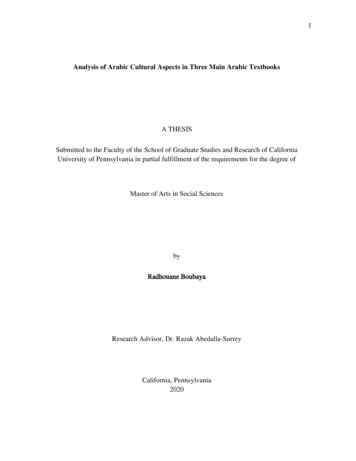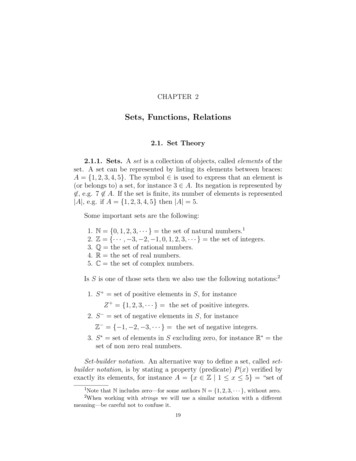
Transcription
Part One:Getting Set Up9
Chapter 1Welcome to My WorkshopA corner of the author’s workshopIwork in an old tobacco-curing barn that has gradually been converted into a well-equipped chairmaker’sworkshop. There’s a large central area with workbenches, several lathes, and a fine view of SugarloafMountain. This is where I teach classes in traditionalchairmaking for Country Workshops, a small handcraftsschool that I started in 1978.Windsor andPost-and-Rung ChairsThe chairs I make are related to two basic styles—postand-rung chairs, and Windsors. Historically, most of theparts for both types were turned on a lathe—picture thelegs and stretchers of a Windsor chair. Turned parts lendthemselves to having round, cylindrical tenons (the projection on a piece of wood that is fitted into a mortise—acavity— to make a joint). Matching round mortises are10quickly bored with a drill. In my chairs, I often use partsshaved with a drawknife instead of turned with a lathe. Ienjoy this way of working wood, and I like the resultingappearance of the handwork.A third type of chair, using rectangular mortise-and-tenonconstruction, is made by a branch of traditional woodworking known as joinery. Joined chairs are generallymade from rectilinear rails (crosspieces) and stiles (posts orlegs), with flat surfaces that form 90-degree angles, insteadof the cylindrical shapes and myriad angles of Windsorsand post-and-rung chairs. Joined chairs were first made atthe same time as turned post-and-rung chairs, but usuallyby different craftspeople. I don’t cover traditional joinedchairmaking in this book.You can recognize post-and-rung chairs by their four-sidedframework composed of cylindrical parts. Continuousposts serve as rear legs and uprights for the back support,which can be slats, vertical spindles, or woven fiber. Post-
Left: A sack-back Windsor made by the author, based on a style fromc. 1790–1800Below: An English post-and-rung ladder-back armchair made byPhilip Clissett (1841–1913)and-rung chairs usually have a seat of flat splints, rush,or fiber woven across the upper round of cross rungs.Although I have never made a wooden seat, these mayalso be used. Six to eight cross rungs located below the seatstrengthen the lower part of the frame.Windsor chairs usually are made entirely of wood, witha solid plank seat and independent leg and back support systems that are bored into the seat at compound angles.The back support and optional armrests typically consistof an array of turned or shaved spindles mortised into theseat, and one or more bent hardwood bows that serve asa frame for the back support and armrests. The legs andtheir connecting stretchers are usually turned, often withdecorative detailing.Several other traditional chair styles share the Windsor’sconstruction, among them Welsh stick chairs, Irish hedgechairs, and the Swedish pinnar. The common Bostonrocker was a commercially popular, late nineteenth-century Windsor. In this book, I call all of these related chairs“Windsors.”Windsor and post-and-rung chairs have several characteristics in common. Unlike most furniture, the parts ofthese chairs can be made from split sections of a straightgrained log, instead of from milled lumber. This splittingprocess is called riving. Rived components are often superior to similar parts produced by sawing, because rivedwood follows the natural fiber configuration of the wood,whereas sawing severs the fibers at an angle. Rived partsare usually stronger (for their weight or mass), and theywill bend easier than sawn parts. The basic post-and-rungchair is simpler than a Windsor, so I always suggest thatchairmaking novices start by producing at least one postand-rung chair. Without significant differences in toolsand equipment, you can produce both types in the sameworkshop.There are several basic types of post-and-rung chairs. Thesimplest is a stool with four legs and eight to twelve crossrungs. The basic post-and-rung dining chair, or side chair,has two or more cross slats for a back support and no armrests. The slats are usually horizontal, but they can also bevertical, mortised between lower and upper crosspieces.For comfort, the backrest should be bent, forming an angleof about 102 degrees between the seat and back. The seatdesign for most of these chairs is a trapezoid, with thefront wider than the back. Post-and-rung construction isalso commonly used for armchairs and rocking chairs.The post-and-rung chair projects in this book were madewith shaved parts, but they can also be turned on a lathe.11 11
Turning is the more common, traditional approach. Abasic, inexpensive lathe is suitable for most chair work, butyou can also make your own lathe for almost no cash outlay. (I’ve included plans for building a spring-pole lathe inPart 4.) Turning wet wood is almost as much fun as shaving wet wood.Part of the appeal of the Windsor style is that you caneasily modify the construction and embellishments to suityour own taste or that of a buyer. The gallery sectionsof this book include a variety of old and contemporaryWindsors and post-and-rung chairs.My personal interest in chairmaking has focused on teaching rather than production. While I appreciate the proficiency that is achieved only by production work, I findthat in teaching I am constantly learning more about thechairs and how to make them. There is always a challengein explaining concepts and methods to students who cometo class with a wide range of expertise and talents. In manyinstances, I’ve picked up an idea or a different method fromone of my students. My chairmaking is limited to producing several chairs a year. These can be post-and-rung chairsor Windsors, depending on the orders I receive.Occasionally I have time to make a chair chosen by whim.My first original chair design was the post-and-rungyouth chair, in Chapter 11. Two more recent chairs that Idesigned are the high-back stick Windsor in Chapter 8 andthe double-bow English-style Windsor in Chapter 17.A contemporary interpretation of a seventeenthcentury joined chair, made by Peter FollansbeeTwo versions of a classic American bow-back Windsor, both made by the author12
Country Woodcraftand Green WoodworkingJohn Alexander, a fellow chairmaker and the author ofMake a Chair from a Tree, once commented on my callingour craft country woodcraft. He said that these craft traditions had both urban and rural roots, that chairmaking, forinstance, was often the work of highly skilled urban joinersand turners. John had coined a new term, green woodworking, as a contemporary conceptualization of an old way ofworking wood. Green woodworkers generally go directlyto the forest for their materials. Logs are split with wedgesinto billets that are shaped into parts for chairs, baskets, andother useful objects—quite a different story from woodworking that relies on lumber that is milled and kiln-dried intouniform sizes before woodworkers gets their hands on it.But country woodcraft is correct also. As the industrial system developed, many traditional handcrafts were abandoned. Surviving practitioners were often rural craftspeople, living in the poorer, backwater areas whereprogress and development were slow. In many cases crafttechniques were lost or forgotten. Lon Reid, a mountainchairmaker in the original Foxfire book, shaved chair postsand rungs with a drawknife. His father and grand father,also chairmakers, used a lathe. When thelathe broke down, it wasn’t repaired. LonReid made do.but green (wet) wood is not suitable for chair joinery. Likemany water-saturated materials, green wood shrinks as itdries. This means that joints made with wet wood will fallapart when the wood dries. Chair assembly is done after thewood has been dried to the appropriate moisture content forthe various parts. (I discuss this in detail in Chapter 4.)My interest in green woodworking began in 1972, whenI apprenticed to a cooper in the Swiss Alps. Before then,I had little experience using traditional hand tools. Forcoopering I used a shaving horse and acquired a froe,drawknife, side hatchet, spokeshave, brace, and auger bit.All are greenwood chairmaker’s tools also.Ladder-Backsand Stick WindsorsIn 1979 John Alexander came to our North Carolinafarmstead to teach Country Workshops’ first course inladder-back chairmaking. At that time, John didn’t knowhow to teach the making of a post-and-rung chair withinthe five-day time frame of the class we offered; instead hetaught how to make post-and-rung stools. They’re simplerand yet provide many of the challenges of making a chair.These rural woodworkers often producedchairs, kitchen woodenware, and other craftswith a direct sense of design, artistry, and honesty lacking in the more pretentious, fashionable products created by urban craftspeopleor in factories. Welsh stick Windsors are oneexample. These chairs are handmade, countryversions of English Windsors. The best Welshchairs use direct, visible construction, displaying a directness of approach and simplicity ofdesign that I admire. Perhaps more importantis the element of personal connection andcharacter found in crafts work that is trulyhandmade.Tools for green woodworking tend to be simple and straightforward. The craft is especially satisfying because the work is a directresult of one’s hand skills, the condition ofone’s tools, and the wood being worked—Continuous-arm Windsors, being made by Dave Sawyera distinct contrast to setting up and operatNow we’ve refined our Ladder-Back Chairmaking courseing a piece of machinery that does the actualto the point where we teach a two-slat ladder-back withwoodworking. Green woodworking is also in harmony withbent back posts—the chair that I explain in Chapter 6.a philosophy of caring for our environment and personalTo give you an idea of how long it takes a novice to makehealth. It calls for local, natural materials. Electricity playssuch a chair, working at it full time, the course is now sixa minor role. Its waste products are mostly wood shavings,days long and includes weaving a Shaker-tape seat on eachrather than sawdust and fine airborne particlescompleted frame.of wood dust and toxic finishes.Green woodworking techniques are great for shaping wood,The chairmakers’ network is a small one. Vermont chair-13 13
A Brief History of theChairmaker’s CraftI am not an authority on the history of making chairs.However, I have always been interested in this subjectand have picked up bits and pieces over the years. WhenI started writing this book, I decided to learn more aboutthe development of the chairs I’ve been making.The earliest and best-known American books on Windsorchairs are Wallace Nutting’s A Windsor Handbook (1917)and his Furniture Treasury (1928). Thomas HamiltonOrmsbee’s The Story of American Furniture (1943) alsoincludes an extensive section on Windsor chairs. Both writers hypothesized an evolution of design and artisanship thatbegins with simple or “primitive” chairs. Step by step, theclassic American Windsor design takes shape. Strange-looking English Windsors precede the more sophisticated andperfectly proportioned Windsors made by North Americancraftspeople in the mid–eighteenth century.An inspirational stick Windsor, from the collection at the Museum of WelshLife, Cardiff, Wales.maker Dave Sawyer, who has taught the Ladder-BackChairmaking workshop several times, in 1983 coached methrough his methods for making a continuous-arm Windsor.While writing this book I visited Dave; his methods stillform the foundation to my approach in making a Windsor.In the spring of 1993 an English colleague, Mike Abbott,visited us. We had corresponded for several years, since thepublication of Mike’s book, Green Woodwork. Mike hadagreed to be the guide for Country Workshops’ upcomingcrafts tour of England and Wales. During his visit, Mikeshowed me a new book, Welsh Stick Chairs. John Brownmakes chairs deeply rooted in the Welsh stick Windsor tradition that also express his personal interpretation of the style.During our tour of England and Wales I had the pleasureof meeting John Brown and seeing his chairs, as well assome of the old chairs at the Museum of Welsh Life.This was my introduction to vernacular Windsors made bycountryside woodworkers. It turns out that stick Windsorswere also made in Ireland, parts of England, and even inthe southern tip of Sweden.14As a chairmaker, for me these books raised serious questions—and some doubts. Through Country Workshops Ihave been fortunate to meet several people who have seriously investigated the chairmaking story. John Alexandertold me about Nancy Goyne Evans when we were planning our first Windsor chairmaking class in 1987. NancyEvans has been investigating Windsor chair history formore than thirty years, researching documents such asinventories and probate records, as well as journals andold artworks. Her article “A History and Backgroundof English Windsor Furniture,” published in FurnitureHistory in 1979, and recent correspondence have beenmajor sources for my information about early Windsorchairs. (Nancy Goyne Evans’s magnum opus, AmericanWindsor Chairs, was published by Hudson Hills in 1996.)My other major source of scholarly chairmaking history has been Bernard Cotton, whose hands-on studyof English woodland crafts and chairmaking went forward under the tutelage of Fred Lambert, the almostlegendary craftsman who wrote Tools and Devices forCoppice Crafts, first published in 1957. Bill Cotton hastwo advanced degrees in social science from LondonUniversity and is the author of numerous articles andseveral books on vernacular English furniture. His comprehensive workThe English Regional Chair is the authoritative study onEnglish ladder-back, spindle-back, and Windsor chairs.Where Nutting was driven by subjective judgment todevelop design standards for determining a fine-qualityWindsor, contemporary researchers like Evans and Cottonare engaged in combining verifiable facts and supportingevidence into an accurate, and often complex, history ofchairmaking.I met Bill Cotton during Country Workshops’ first tour ofEngland and Wales, when he and his wife, Gerry, hostedour group with a traditional plowman’s lunch, followed by
“Men Shoveling Chairs” by a Master at Flanders, c. 1445. A rare chance to study a selection of realistically rendered period chairs.a slide lecture on Philip Clissett, a nineteenth-century ruralchairmaker who influenced William Morris and others inthe English Arts and Crafts movement. For this book, BillCotton has graciously loaned me several color plates ofoutstanding English chairs.I also recommend American Seating Furniture, by BennoM. Forman, which includes several in-depth essays onthe methods used by furniture historians as well as onthe development of various chair styles and how they areinterrelated.The history of post-and-rung and Windsor chairmakingturned out to be more complex than I had anticipated,with many gaps still to be filled in—the fabric of this storyis a weave of known and as yet unfound threads in whichexceptions seem to accompany most statements of fact.Much of what I say is still speculative, or in the realm ofgeneralization.Because wood decays and burns, the study of very earlyfurniture depends largely on artworks and documents inwhich chairs play an incidental role. Surviving artworksclearly show that wooden chairs were being made threeor four thousand years ago. The basic wooden-seatingconcept, a stool consisting of a plank seat housing threeor four socketed legs, occurs in a few examples traced toThebes, Egypt (about 1,400 BC). This is the same construction method used in Windsor chairs. Examples ofrectangular rush-seated stools have been dated before thebirth of Christ. We also know that wooden stools, chairs,and tables were made by the Romans and throughoutthe Middle Ages, but no pieces are known to survive. Afew artworks from the thirteenth to the fifteenth centuriesdepict furniture and woodworkers using tools very like thetraditional hand tools that we are familiar with.In a pen, ink, and chalk drawing from Flanders datedabout 1445, “Men Shoveling Chairs,” men with long handled wooden shovels are piling a variety of period seating into a heap. Most of the chairs were turned, althoughseveral plank stools also appear in the picture. Quite a fewof the turned stools in the picture have three legs, andthere are also several folding chairs. A joined chair withwoven seat and backrest is at the top of the pile.A guild of turners formed in London in the early fourteenth century lists, in Article 4 of its 1608 ordinances,wares commonly produced by turners at that time, including chairs and spinning wheels. These were mostly postand-rung chairs, with rush or plank seats. An engravingfrom about 1635, “The Turner” by the Flemish artist Janvan Vliet, depicts a craftsman at his spring-pole lathe.Against the back wall we clearly see a conventional postand-rung chair with a solid plank seat, and in the foreground a spinning wheel appears prominently.No research has yet convincingly explained why Windsor15 15
Windsor chairs.The earliest known written references to Windsor chairspredate the oldest provenanced Windsors by severaldecades. In 1718, Stephen Switzer wrote a treatise onrural gardening where he described “a large Seat, call’d aWindsor Seat, which is contriv’d to turn round any way,either for the Advantage of the Prospect, or to avoid theInconveniences of Wind, the Sun, &c.” Daniel Defoe wroteabout a chair he saw at Windsor Castle in 1725 “with ahigh Back, and Cover for the Head, which turns so easily,the whole being fix’d on a Pin of Iron, or Brass of Strengthsufficient, that the Persons who sit in it, may turn it from theWinds.” Defoe describes the construction as being similarto an open box, with board sides, back, and top. The chairdoes not begin to resemble what we call a Windsor.The earliest Windsors were most likely fairly elaboratechairs. The post-and-rung chairs and spinning wheels produced by the master guild turners were the work of skilledartisans. There is no reason to suppose that these turnerswould produce primitive furniture.“The Turner,” by Jan van Vliet, c. 1635, one in a series of illustrationsdepicting early seventeenth-century Flemish tradeschairs are called “Windsors.” According to Nancy Evans,it is almost certain that the first Windsors were madeby master turners in London, not in the small town ofWindsor, based on the following findings: The earliestprovenanced Windsor-style chairs do not appear until themid-eighteenth century. In the early 1720s the registers ofapprenticeship indentures listed twenty-eight master turners in London. The town of Windsor is located in countyBerkshire, about thirty miles west of London. Four parentsliving in county Berkshire sent their sons away for training as turners. Two boys went to London, one went to theReading (slightly west of Windsor), and the other wentto East Sussex, which is directly south of London. It istherefore probable that there were few, if any, turners living in Windsor during the formative years of the EnglishWindsor chair style.My own hunch is that a decline in the sale of turnedspinning wheels plays an important part in the story. Thedevelopment of the Windsor style coincides with thebeginnings of industrialization. The early development ofwoolen mills resulted in a rapid decline in home spinning,which had been an important cottage industry throughoutmuch of rural Britain. As a woodworker, when I look ata spinning wheel, I see little technical difference from aWindsor chair. Both consist of turned legs, spindles, andother cylindrical parts that intersect a tilted central plankat myriad angles. I believe that some of the craftspeoplewho had been making spinning wheels turned to making16While old, vernacular Windsor-type chairs with plainlegs and simple lines do exist, they are impossible to date.According to Evans, it is almost certain that stick Windsorsand other vernacular chairs were not progenitors of theWindsor style but rural versions of fancier chairs madeby contemporary professional turners—yet this remainsan open question. Leg angles and other details of existingold stick Windsors suggest that these chairs were generally made by part-time woodworkers. Construction andmaterials indicate that they were made by and for members of the lower economic classes. This perspective in noway lowers the value of the stick Windsors and other ruralvariations.The industrial revolution created the factory production system beginning in the eighteenth century. HighWycombe, in Buckinghamshire, England, was an earlycenter of factory-made Windsors. The needed wood wasavailable nearby, and the major market —London—is notfar to the east. These chair factories were among the firstto organize production by specialized division of labor anduse of interchangeable parts. Depending on the size of thefactory, there were turners, seat saddlers, fret workers (whosawed intricate patterns in the central back splats commonto English Windsor chairs), assemblers, finishers, and soon. Production was done on a piecework basis, with craftspeople usually working as independent contractors. Thebusiness was highly competitive, with long hours and lowpay, and factory owners were constantly looking for waysto lower production costs. According to Bill Cotton, by themid-1870s High Wycombe had nearly a hundred chairfactories, producing more than four thousand chairs a day.Several English books on rural crafts tend to romanticizeearly Windsor chairmaking history, especially the role ofitinerant woodland turners, known as “bodgers,” who setup temporary shelters in the beech woodlands and used
homemade spring-pole lathes to produce Windsor turningsas piecework. (Bill Cotton has researched the term bodger,a word apparently first used by journalists in the earlytwentieth century to refer to woodland turners; it seems tobe a derogatory term, deriving from botcher.) A pole latheis driven by a cord wound around the turning and pulleddownward by a foot treadle. An overhead spring pole pullsthe cord back after each downward stroke. That the actionis reciprocal, rather than continuous, limits the speed ofwork, as half the time—when the turning is spinning inreverse—no cutting is done. Although the method is inefficient, an accomplished pole-lathe turner can producequality turnings at an impressive rate. But—as distinctfrom these romanticized “bodgers”—most of the HighWycombe area turners actually worked in sheds next totheir village homes (not under trees), and they generallyused treadle lathes, which turn continuously in one direction and are therefore more efficient than pole lathes.In the 1600s, North American craftspeople were making chairs in a variety of styles. Turners made bothspindle-back and slat-back post-and-rung chairs. “Greatchairs”—joined chairs with arms—were prominent household furnishings, but simple side chairs and benches weremore common. The seats could be planking, rush, cane, orflat woven splints. Joined chairs tended to have solid plankseats, but some were upholstered with leather, or “turkeywork,” a woven ruglike fabric. Joined chairs commonlyfeatured decorative turned elements worked between therectangular mortise-and-tenon construction. Caned chairswere apparently among the types made by the first artisanswho called themselves “chairmakers.” According to BennoForman, high-style caned chairs peaked in popularity forthe several decades that preceded the rise of the Windsorstyle, in the mid-1700s.No one is sure when the first Windsor chairs were madein the North American colonies. By the late 1700s, mostWindsors made in the young United States were producedin factories, using interchangeable parts and specializeddivision of labor. Many early chairmakers were actually entrepreneurs, not master artisans working with anapprentice or two. In 1775, Francis Trumble advertisedin the Pennsylvania Gazette that he had 1,200 availablechairs in stock. On October 22, 1801, James Hallett Jr.placed this ad in the New York Gazette: “For Sale 5,000windsor chairs of various patterns, prepared for a Foreignmarket of the very best materials and workmanship.”Still, handmade chairs continued to be produced in smallquantities in England and the United States. In general,one-person shops were more likely to produce post-andrung chairs than Windsors, probably because almost allparts of a post-and-rung chair can be made on a lathe.In contrast, producing a Windsor requires mastery of awide range of craft skills. It is likely that many craftspeoplewho could single-handedly make fine Windsor chairs weremostly occupied with repair work. This would explain theindividual, sometimes eccentric, quality of many older,English Windsor chairmaker Jack Goodchild at work in Naphill, Bucking ham shire, c. 1950. His methods and finished chairs were very similar toEnglish Windsors made in the late eighteenth century.handmade Windsors that survive today.Windsor and post-and-rung chairs should not be stereotyped as either urban or country furniture. Although thefirst Windsors seem to have been produced in London,rural and village workshops were soon turning out similarchairs. Chairs made in factories and by individual craftspeople could be of high quality or quickly produced forthe lower-priced markets.The interpretive Windsor history writings of Nutting andOrmsbee appear to go off track when they describe theevolution of the American Windsor as a refinement ofthe English Windsor style. I agree that the best AmericanWindsors made between 1775 and 1825 are elegant piecesof furniture, but I do not find the American Windsor stylesuperior, or more refined. While working recently on myfirst English-style—or perhaps English-inspired—Windsor(a project chair in Chapter 17), I developed new respectfor the old English chairmakers. It may be that manycharacteristics of American Windsor chairs were originallydeveloped by a desire to produce more quickly a morecompetitive chair, and perhaps something different for themarket—the American Windsor style tends to be considerably lighter than English Windsors, and the angles used forboring legs and back bows are dramatic.Eighteenth-century American Windsors were commonlypainted black or green. To the uninitiated, painting awooden chair often seems like sacrilege. However, paintedwooden furniture was very popular from the seventeenthinto the nineteenth centuries. While the English often17 17
coats were required to build up a substantial amount ofcolor, giving the finish a rich depth not found in modernpaints, which use much higher concentrations of pigmentbut no lead. According to Nancy Evans, the deep forestgreen commonly associated with American Windsors wasnot commonly used until well into the nineteenth century.The recipe combined blue, red, and yellow pigments withlampblack.English and American Windsors of similar basic construction commonly go by different names. To confuse matters,the names of English and American Windsor back stylesare not consistently used either from one area to anotheror among the craftspeople who make them. I’ve compileda few of these confusing English and American Windsornames (for consistency, in this book I use the names thatare followed by the asterisk ,*great WindsorHigh-back, comb-backBow-back,* hoop-back,loop-back, oval-back,side bow-backLow-back, hoop-backSack-back,* bow-backLow-back, high hoop-back,high stick-back, double bowback,* smoker’s high-back,high stick-back, low stick-backLow-back,* captain’s chairLow bow-back, smoker’sbow-back, library chairContinuous arm,*one-piece bow and armContinuous arm(produced in southwestEngland, mid-1800s)Fan-backComb-backJack Goodchild dipping finished chairs in a vat of stain, which would be followed by a coat of shellac varnishmade Windsors from wood species chosen for their appearance, American Windsor chairmakers commonly usedwoods that served their special construction purposes butwere not aesthetically compatible. Painting tied the chairtogether visually. And here’s a secret from the old workshops: Painting also helps to conceal errors in craftsmanship, hiding repairs and sometimes defects. Early AmericanWindsors were painted with oil colors that were quite similar to artists’ oils used for pictures. Completed chairs wereprimed with linseed oil and lead-based grey paint, then finished with several thin coats based on a mixture of linseedoil, pigment, lead, varnish, and sometimes turpentine.The green paint popular for eighteenth-century AmericanWindsors was based on verdigris, a toxic pigment obtainedby the reaction of acetic acid on copper. The colorresembles that of oxidized copper (sometimes Prussianblue was added). An unstable substance, verdigris reactswith other chemicals that it contacts, and the actual huecan range from turquoise green to bright blue. Several18
The Swedish Windsor TraditionThe Swedes have their own version of Windsor chairs,pinnar. “Pin” is a derivative of “spindle.” Although itseems unlikely, it is apparently true that Windsors cameto Sweden from America, not from England. As I recentlydiscovered when I had a chance to examine a large number of Swedish pin chairs in the warehouse of the NordicMuseum, the turning patterns of their legs and stretchersare based on American patterns, which differ considerablyfrom most English Windsor turnings. Most Swedish pinnarwere inexpensive side chairs produced in factories, butmany were also made by individual craftspeople. Popularabout 1900, low-backs and small fan-back side chairs arethe most common styles.A stick Windsor from the southern tip of the Swedishcoast. A baby seal-skin fur belongs in the hollow partof the seat.The Swedes also invented a unique Windsor recliner, de rivedfrom the American “Boston rocker,” with the same generous S-profile seat, tall back, and large comb at the h
basic, inexpensive lathe is suitable for most chair work, but you can also make your own lathe for almost no cash out-lay. (I’ve included plans for building a spring-pole lathe in Part 4.) Turning we










